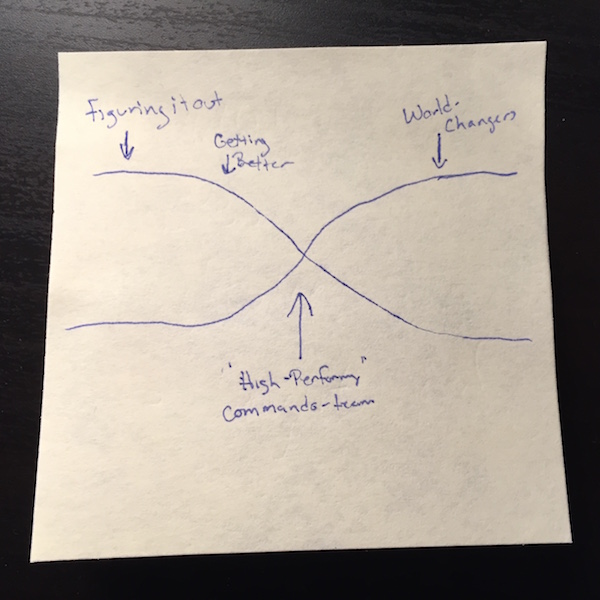A Model For High Performing Teams
We all love throwing around, “High-Performing,” teams as something that you get when you transition to agile beliefs and practices. This high-performing team could be described many ways, and I’ll try to provide a way to think about the journey a team takes as they become high-performing.
With that, I give you the hyperbola of high performance!

The left side of the hyperbola is where most of us live our lives on agile teams. If you’re familiar with the Forming, Storing, Norming, Performing model for teams then this covers the first 3. This area is difficult to escape because there is so much room to be lost in it. Now, in this area the team will be getting comfortable with themselves, their team mates, and the agile practices. They will also, and almost more importantly, begin to see these same activities take place throughout their immediate managers. Because these two groups are both somewhat independently finding their own path, most teams take years to get out of this area and wind up jaded and abandon their journey.
If teams get out of this swamp of discovery, they will become more self-directed and self-possessed to do a great job. They will begin to challenge aspects of their job, management, and processes so that they can do better. This is focal point in the image. This is where a team becomes extremely focused and driven. They have the skills, practice, and understanding to start really delivering high quality work. Now, I want to make it clear that this moment is when a team self-organizes around getting something done. They will become zealous towards accomplishing whatever goals that are set.
Now, this sounds great and it is, but there is actually more. What is happening in this time is that the team is pooling together and asking, “What will it take to get this done?” This is a powerful and important moment for a team to go through, but not the end. At this time, the team can almost adopt a sort of tunnel vision where if they see a plan that can succeed, they become blind to all the other alternatives in their pursuit of accomplishing their goals.
Which brings us to the right hand side of the hyperbola. After the team has hit this focal point, and the team has been encouraged appropriately, they will begin to truly become high-performing. Their dogged pursuit of getting things done will relax, but they will still get things done. The team will then begin to take a little longer to explore, discuss, and collaborate with people outside of their group the many alternatives that can exist. They will do this independently. At the focal point, usually a leader emerges that drives the team. At this stage, by contrast, people just take it upon themselves to go investigate. The solutions get better and better at this point.
For a different analogy, imagine a target in a field. This target has many rings and a bulls-eye. The left half of this hyperbola represents the team trying to hit that target. The focal point represents the time when they can consistently hit it, and the right half represents the time when the target is completely and totally eradicated.
Many of us get very excited when the team begins to hit the target consistently. We stop looking to see if the part we hit was the part we needed to or intended to. We believe that our consistency is accuracy. Instead, we need to continue to inspect and adapt, so that when we are trying to hit a target, we aren’t satisfied by simply hitting it, but instead hitting all of it through investigation, exploration, and prototyping of all of the alternatives. High-performing teams do the best work, because they already discovered the other possibilities and rejected them.
